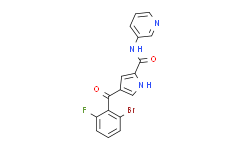| Cas No.: | 1888305-96-1 |
| Chemical Name: | Erk5-IN-2 |
| Synonyms: | ERK5-IN-2;4-(2-bromanyl-6-fluoranyl-phenyl)carbonyl-~{N}-pyridin-3-yl-1~{H}-pyrrole-2-carboxamide;4-(2-Bromo-6-fluorobenzoyl)-N-(pyridin-3-yl)-1H-pyrrole-2-carboxamide;9N8 |
| SMILES: | BrC1=C([H])C([H])=C([H])C(=C1C(C1=C([H])N([H])C(C(N([H])C2=C([H])N=C([H])C([H])=C2[H])=O)=C1[H])=O)F |
| Formula: | C17H11BrFN3O2 |
| M.Wt: | 388.1905 |
| Purity: | >98% |
| Description: | ERK5-IN-2 is an orally active, sub-micromolar, selective ERK5 inhibitor with IC50s of 0.82 μM, 3 μM for ERK5 and ERK5 MEF2D, respectively. ERK5-IN-2 does not interact with the BRD4 bromodomain. ERK5-IN-2 suppresses both tumor xenograft growth and basic fibroblast growth factor (bFGF) driven Matrigel plug angiogenesis[1]. |
| In Vivo: | ERK5-IN-2 (compound 46) (p.o.; 100 mg/kg; CD1 mice for 7 days and CD1 nude (nu/nu) mice for 10 days) has an anti-angiogenic effect and low concentrations of haemoglobin[1]. ERK5-IN-2 (i.v. or p.o.; 10 mg/kg for 0.083-24 hours) exhibits low intrinsic clearance and has high flux and a low efflux ratio (ER) in a caco-2 cell permeability assay in both human and mouse[1]. Animal Model: Female CD1 mice (8-10 weeks old) with Matrigel inoculation and female CD1 nude (nu/nu) mice (8-10 weeks old) bearing A2780 human ovarian carcinoma xenografts[1] Dosage: 100 mg/kg Administration: P.o.; twice-daily; CD1 mice for 7 days and CD1 nude (nu/nu) mice for 10 days Result: Tumor volumes were significantly reduced. Animal Model: Female CD1 mice at 8-10 weeks of age[1] Dosage: 10 mg/kg Administration: I.v. or p.o.; 0.083-24 hours Result: The terminal plasma half-life was 38 min, with a plasma clearance of 27 mL/min/kg, and oral bioavailability of 68%. |
| References: | [1]. Myers SM, et al. Identification of a novel orally bioavailable ERK5 inhibitor with selectivity over p38α and BRD4. Eur J Med Chem. 2019 May 25;178:530-543. |

 DC Chemicals' products qualify for U.S. tariff exemptions. We guarantee no price increases due to customs duties and maintain stable supply, continuing to deliver reliable research solutions to our American clients.
DC Chemicals' products qualify for U.S. tariff exemptions. We guarantee no price increases due to customs duties and maintain stable supply, continuing to deliver reliable research solutions to our American clients.





















